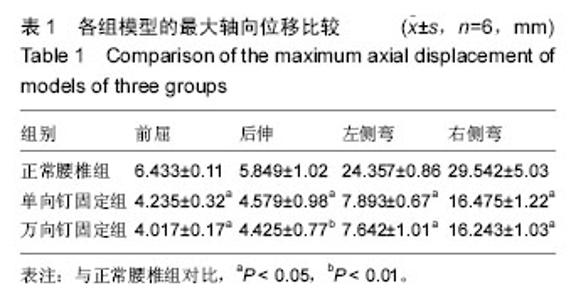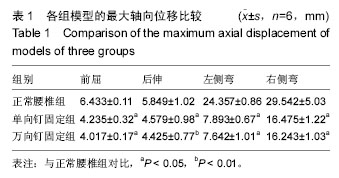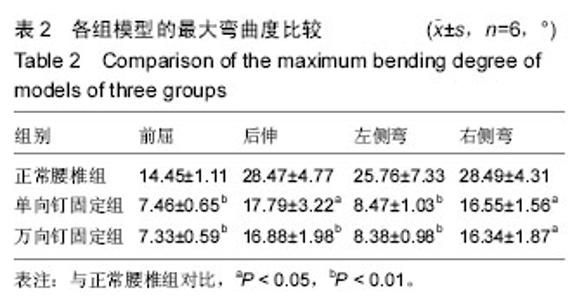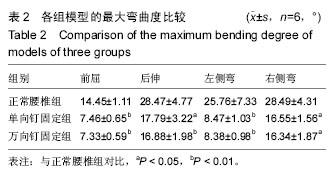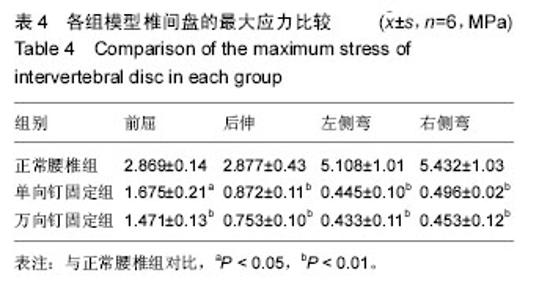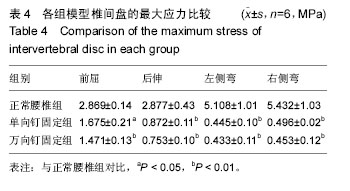Chinese Journal of Tissue Engineering Research ›› 2016, Vol. 20 ›› Issue (22): 3308-3314.doi: 10.3969/j.issn.2095-4344.2016.22.016
Previous Articles Next Articles
One-way versus universal pedicle screw fixation for lumbar fractures: biomechanics
1昌邑市人民医院脊柱外科,山东省昌邑市 261300;2山东大学附属医院骨外科,山东省济南市 276000
- 1Department of Spine Surgery, Changyi People’s Hospital, Changyi 261300, Shandong Province, China; 2Department of Bone Surgery, Affiliated Hospital of Shandong University, Jinan 276000, Shandong Province, China
-
Revised:2016-04-11Online:2016-05-27Published:2016-05-27 -
Contact:Lv Sheng-jiang, Studying for master’s degree, Attending physician, Department of Spine Surgery, Changyi People’s Hospital, Changyi 261300, Shandong Province, China -
About author:Lv Sheng-jiang, Studying for master’s degree, Attending physician, Department of Spine Surgery, Changyi People’s Hospital, Changyi 261300, Shandong Province, China
CLC Number:
Cite this article
Lv Sheng-jiang, Fu Li-juan, Li Hong-mei. One-way versus universal pedicle screw fixation for lumbar fractures: biomechanics[J]. Chinese Journal of Tissue Engineering Research, 2016, 20(22): 3308-3314.
share this article
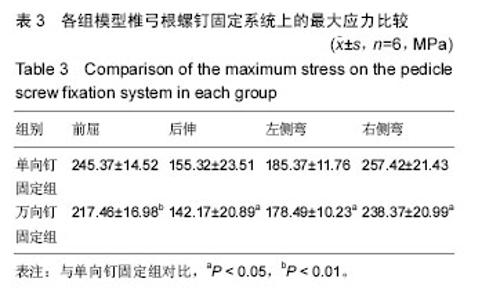
2.3 各组模型椎弓根螺钉固定系统上的最大应力 在腰椎前屈时,单向钉固定组和万向钉固定组的最大应力均集中在连接棒和伤椎上下2个椎体的内固定螺钉根部,在腰椎后伸时,单向钉固定组和万向钉固定组的最大应力集中在邻近伤椎的下面椎体螺钉内固定的根据以及连接棒的下端,在左侧弯时,单向钉固定组和万向钉固定组的最大应力主要集中在左侧伤椎邻近的椎体内固定螺钉根部和左侧的连接棒上,在右侧弯时,单向钉固定组和万向钉固定组的最大应力主要集中在右侧伤椎邻近的椎体内固定螺钉根部和右侧的连接棒上。腰椎骨折椎弓根螺钉内固定后椎弓根螺钉内固定系统承载了大多数的轴向力,使腰椎骨折椎弓根螺钉内固定后承载轴向应力的能力比较强。其中万向钉固定组在前屈、后伸、左侧弯和右侧弯时椎弓根螺钉固定系统上的最大应力均低于单向钉固定组(P < 0.05-0.01),见表3。"
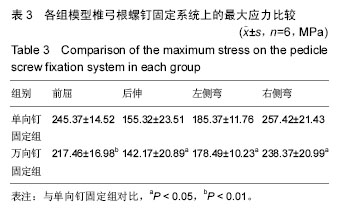
| [1] 顾龙殿.伤椎骨水泥成形联合椎弓根钉内固定治疗老年胸腰椎骨折[J].中国骨与关节损伤杂志,2010, 25(3): 231. [2] 吕夫新,黄勇,张强,等.胸腰椎骨折伤椎椎弓根内固定生物力学研究与临床应用[J].脊柱外科杂志,2008,6(4): 229-233. [3] 范志丹,夏虹,昌耘冰,等.伤椎传统短节段椎弓根螺钉固定与附加椎弓根螺钉固定后椎体生物力学稳定性的比较[J].中国组织工程研究与临床康复,2008,12(26): 5011-5014. [4] Dick JC,Jones MP, Zdeblick TA, et al. A biomechanical comparison evaluating the use of intermediate screws and cross-linkage in lumbar pedicle fixation. J Spinal Disord. 1994; 7(5): 402-407. [5] Anekstein Y, Brosh T, Mirovsky Y. Intermediate screws in short segment pedicular fixation for thoracic and lumbar fractures : a biomechanical study .J Spinal Disord Tech. 2007;20(1): 72-77. [6] 胡樵,黄勇,赵东升,等.胸腰椎骨折伤椎椎弓根内固定的生物力学研究[J].河北医学, 2008, 14(7):757-761. [7] Mahar A, Kim C, Wedemeyer M, et al. Short-segment fixation of lumbar burst fractures using pedicle fixation at the level of the fracture. Spine(Phila Pa 1976). 2007; 32(14): 1503-1507. [8] Gelb D, Ludwig S,Karp JE,et al. Successful treatment of thoracolumbar fractures with short-segment pedicle instrumentation. J Spinal Disord Tech. 2010;23(5) : 293-301. [9] Lewkonia P,Paolucci EO,Thomas K. Reliability of the thoracolumbar injury classification and severity score and comparison with the denis classification for injury to the thoracic and lumbar spine. Spine. 2012;37(26) : 2161-2167. [10] van Middendorp JJ,Patel AA,Schuetz M,et al. The precision,accuracy and validity of detecting posterior ligamentous complex injuries of the thoracic and lumbar spine: a critical appraisal of the literature. Eur Spine J. 2013;22(3):461-474. [11] Joaquim AF,Ghizoni E,Tedeschi H,et al.Clinical results of patients with thoracolumbar spine trauma treated according to the Thoracolumbar Injury Classification and Severity Score. J Neurosurg Spine. 2014;20(5): 562-567. [12] Pneumaticos SG,Triantafyllopoulos GK,Giannoudis PV. Advances made in the treatment of thoracolumbar fractures: current trends and future directions. Injury. 2013;44(6): 703-712. [13] Vaccaro AR,Oner C,Kepler CK,et al. AO Spine thoracolumbar spine injury classification system: fracture description,neurological status,and key modifiers. Spine. 2013;38(23) : 2028-2037. [14] Allain J. Anterior spine surgery in recent thoracolumbar fractures: An update. Orthop Traumatol Surg Res. 2011; 97(5):541-554. [15] Hsieh MK,Chen LH,Niu CC,et al. postoperative anterior spondylodiscitis after posterior pedical screw instrumentation. Spine J. 2011;11(1):24-29. [16] Fisher SC,Shores A,Simpson ST. Constrictive myelopathy secondary to hypoplasia or aplasia of the thoracolumbar caudal articular processes in Pugs: 11 cases(1993-2009). J Am Vet Med Assoc. 2013;242(2) : 223-229. [17] Shang J,Ling XD,Liu YC,et al. Biomechanical effects of pedicle screw adjustments on the thoracolumbar burst fractures. Chin Med J(Engl). 2013;126(2): 300-305. [18] 鲁世保,孔超,海涌,等.单节段与双节段经伤椎椎弓根钉固定治疗轻中度不稳定胸腰椎骨折的疗效[J]. 中华骨科杂志,2013,33(6): 615-620. [19] Grabowski G,Cornett CA. Bone graft and bone graft substitutes in spine surgery: current concepts and controversies. J Am Acad Orthop Surg. 2013;21(1): 51-60. [20] Wu H,Wang CX,Gu CY,et al. Comparison of three different surgical approaches for treatment of thoracolumbar burst fracture.Chin J Traumatol. 2013; 16(1):31-35. [21] Adkins DE,Sandhu FA,Voyadzis J.Minimally invasive lateral approach to the thoracolumbar junction for corpectomy.J Clin Neurosci. 2013;20(9) : 1289-1294. [22] Dong SH,Chen HN,Tian JW,et al. Effects of minimally invasive percutaneous and transspatium intermuscular shortsegment pedicle instrumentation on thoracolumbar monosegmental vertebral fractures without neurological compromise. Orthop Traumatol Surg Res. 2013;99(4):405-411. [23] Gu Y,Zhang F,Jiang X,et al. Minimally invasive pedicle screw fixation combined with percutaneous vertebroplasty in the surgical treatment of thoracolumbar osteoporosis fracture. J Neurosurg Spine. 2013;18(6):634-640. [24] Vanek P,Bradac O,konopkva R,et al.Treatment of thoracolumbar trauma by shortsegment percutaneous transpedicular screw instrumentation: prospective comparative study with a minimum 2 year followup. J Neurosurg Spine. 2014;20(2): 150-156. [25] 幸永明,王振林,刘伟,等.经皮椎体成形术治疗胸腰椎压缩骨折350 例临床研究[J].临床军医杂志,2012,39(5) : 1047-1049. [26] 彭春政,张胜年,陆爱云.人体躯干骨骼-肌肉-韧带结构三维有限元模型的建立和验证[J].中国运动医学杂志, 2010,29(6):702-705. [27] 方国芳,林荔军,于博,等.不同状态下股骨的应力分布及临床应用[J].中国组织工程研究,2012,16(17):3045-3047. [28] 孙卫东,温建民.足部有限元建模方法应用现状[J].中国组织工程研究与临床康复,2010,14(13):2457-2461. [29] 黄诸侯,李俊,陈日齐,等.跟骨三维有限元模型的建立及其骨折发生机制[J].中国骨伤,2012,25(2):97-101. [30] 李晓淼,沈奕,王伟力.全膝关节假体三维有限元模型的建立[J].中国组织工程研究与临床康复,2011,15(13): 2304-2308. [31] 袁平,王万春.膝关节三维有限元模型的建立及生物力学分析[J].中南大学学报,2010,35(1):85-89. [32] 李正东,邹冬华,刘宁国,等.人体骨盆有限元模型的建立及其在法医学鉴定中的应用价值[J]. 法医学杂志, 2010, 26(6):406-412. [33] Belytschko T, Briggs CA. Finite element stress analysisof an intervertebral disc. J Biomech. 1992; 974(7): 277-279. [34] Liu YK, Murray JD. Mechanism of spinal injury due to caudocephalad acceleration. Orthop Clin North Am. 1975;6: 19-21. [35] Brolin K, Halldin P. Development of a finite element model of the upper cervical spine and a parameter study of ligament characteristics.Spine. 2004;29(4): 376-385. [36] 王友良,杨杰山.三维有限元分析在颈椎生物力学中的研究现状[J].临床骨科杂志,2011,14(1):89-92. [37] Chen X, Wu H, Zhou W. The establishment and development of finite elementmodel of human cervicalvertebra and its applicati on example. Chin J Med Biol Eng. 2008;17(2): 154-156. [38] 孟立民,苏啸天,张银光,等.微型外固定支架和克氏针治疗Bennett骨折的三维有限元分析[J]. 中国组织工程研究, 2012,16(9):1626-1630. [39] 王志杰.有限元法在骨应力分析及骨科内外固定系统研究中的应用[J].中国临床解剖学杂志,2006,24(1): 107-110. [40] 王光达,张祚福,齐晓军,等.膝关节三维有限元模型的建立及生物力学分析[J].中国组织工程研究与临床康复, 2010, 14(52):9702-9705. |
| [1] | Shi Bin, An Jing, Chen Long-gang, Zhang Nan, Tian Ye . Influencing factors for pain after total knee arthroplasty [J]. Chinese Journal of Tissue Engineering Research, 2017, 21(7): 993-997. |
| [2] | Wang Xian-xun. Impact of local compression cryotherapy combined with continuous passive motion on the early functional recovery after total knee arthroplasty [J]. Chinese Journal of Tissue Engineering Research, 2017, 21(7): 998-1003. |
| [3] | Yuan Wei, Zhao Hui, Ding Zhe-ru, Wu Yu-li, Wu Hai-shan, Qian Qi-rong. Association between psychological resilience and acute mental disorders after total knee arthroplasty [J]. Chinese Journal of Tissue Engineering Research, 2017, 21(7): 1015-1019. |
| [4] | Chen Qun-qun, Qiao Rong-qin, Duan Rui-qi, Hu Nian-hong, Li Zhao, Shao Min. Acu-Loc®2 volar distal radius bone plate system for repairing type C fracture of distal radius [J]. Chinese Journal of Tissue Engineering Research, 2017, 21(7): 1025-1030. |
| [5] | Huang Xiang-wang, Liu Hong-zhe. A new low elastic modulus of beta titanium alloy Ti2448 spinal pedicle screw fixation affects thoracic stability: biomechanical analysis [J]. Chinese Journal of Tissue Engineering Research, 2017, 21(7): 1031-1035. |
| [6] | Xie Qiang. Three-dimensional finite element model for biomechanical analysis of stress in knee inversion and external rotation after posterior cruciate ligament rupture [J]. Chinese Journal of Tissue Engineering Research, 2017, 21(7): 1036-1040. |
| [7] | He Ze-dong, Zhao Jing, Chen Liang-yu, Li Ke, Weng Jie. Multilevel finite element analysis on the biological tribology damage of water on bone tissue [J]. Chinese Journal of Tissue Engineering Research, 2017, 21(7): 1041-1045. |
| [8] | Li Jing, Yang Long, Wang Jian-ji, Liu Qin, Zou Qiang, Sun Yu, Ma Min-xian, Ye Chuan. Three-dimensional reconstruction based on DICOM data and its application for orthopedic implants [J]. Chinese Journal of Tissue Engineering Research, 2017, 21(7): 1046-1051. |
| [9] | Jiang Zi-wei, Huang Feng, Cheng Si-yuan, Zheng Xiao-hui, Sun Shi-dong, Zhao Jing-tao, Cong Hai-chen,Sun Han-qiao, Dong Hang. Design and finite element analysis of digital splint [J]. Chinese Journal of Tissue Engineering Research, 2017, 21(7): 1052-1056. |
| [10] | Wang Fei, Liu Zhi-bin, Tao Hui-ren, Zhang Jian-hua, Li Chang-hong, Cao Qiang, Zheng Jun, Liu Yan-xiong, Qu Xiao-peng. Clinical efficacy of preoperative osteotomy designs using paper-cut technology versus photoshop software for ankylosing spondylitis with kyphosis [J]. Chinese Journal of Tissue Engineering Research, 2017, 21(7): 1057-1063. |
| [11] | Li Peng, Li Hong-wei, Wang Shuang, Wang Hai-zhou. Digital anatomy of lumbar spinous process tilt angle of adults in northeast China: prodinding reference for pedicle screw insertion [J]. Chinese Journal of Tissue Engineering Research, 2017, 21(7): 1064-1068. |
| [12] | Li Hui, Ma Jun-yi, Ma Yuan, Zhu Xu . Establishment of a three-dimensional finite element model of ankylosing spondylitis kyphosis [J]. Chinese Journal of Tissue Engineering Research, 2017, 21(7): 1069-1073. |
| [13] | Ling Guan-han, Ou Zhi-xue, Yao Lan, Wen Li-chun, Wang Guo-xiang, Lin Heng-feng. Establishment of simulating three-dimensional model of China-Japan Friendship Hospital Classification for L type osteonecrosis of the femoral head [J]. Chinese Journal of Tissue Engineering Research, 2017, 21(7): 1074-1079. |
| [14] | Fu Wei-min, Wang Ben-jie. Assessing the degree of necrotic femoral head, and association of blood supply with pathlogical changes: study protocol for a diagnostic animal trial [J]. Chinese Journal of Tissue Engineering Research, 2017, 21(7): 1086-1091. |
| [15] | Zhang Wen-qiang, Ding Qian, Zhang Na. Associations between alpha angle and herniation pit on oblique axial magnetic resonance imaging in asymptomatic hip joints of adults [J]. Chinese Journal of Tissue Engineering Research, 2017, 21(7): 1098-1103. |
| Viewed | ||||||
|
Full text |
|
|||||
|
Abstract |
|
|||||
